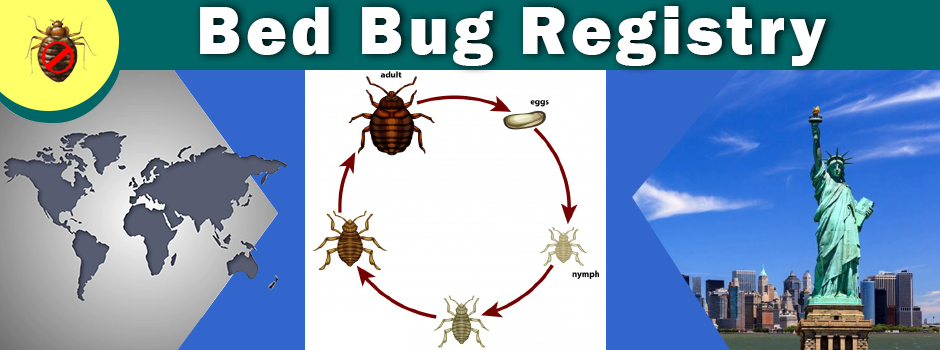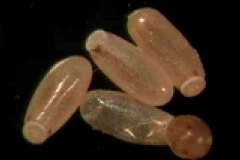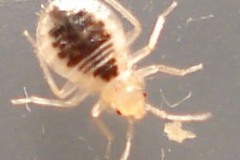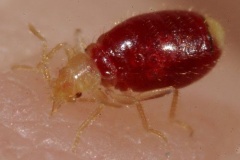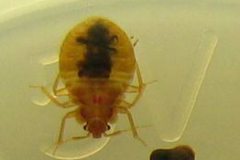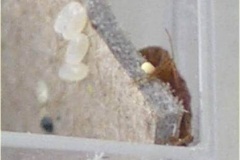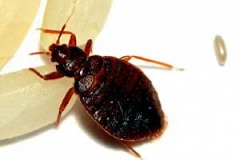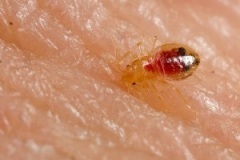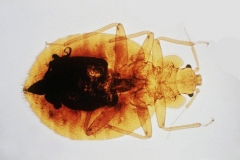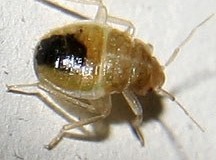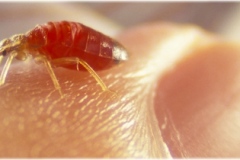Some fast bed bugfacts What do bed bugs look like? Briefly: 1/4 long, oval, flat, 6 legs, and reddish-brown.
A bed bug has 6 legs. Its antennae point forward and are about half as long as the bodynot longer. Its head is broadly attached to its body and it has no wings. Eight legs indicate a tick or mite. Six legs and long antennae with two spikes coming off the back (cerci) might be a roach nymph. Carpet beetle larvae have hairs all over their bodies. Carpet beetle adults have two hard wings.
A drop of blood with legs is probably a recently fed bed bug. It will be red, plump, and oval. After it digests its meal, itll be mahogany-colored, round, and flat. Unfed nymphs are tan. Eggs are oval, white, and stick to whatever theyre laid on.
You can see the adultstheyre about 1/4 long. The trick is finding their hiding spots. They can wedge themselves into any crack or crevice. If the edge of a credit card can fit, so can a bed bug. Eggs and just-hatched nymphs are tiny: 1/16 (1mm) longthe size of the R in LIBERTY on a penny. Theyll plump up after feedingjust like a mosquito.
Bed bugs crawlscurrying into dark, tight spaces to hidethey move as fast as an ant. They cant jump or fly and youll never find them burrowing into your skin. If the insect you have came out on its own accord at night when the lights were out near the bed or a couch, it was probably a bed bug looking for a meal. Bed bugs arent social insects like ants, so they dont need a colony. But while they group together in good hiding spots, loners could be hiding elsewhere.
More on bed bug biology (and yes, it matters): they have an odd way of making babies. Its called traumatic insemination. Males simply stab females in the side with their reproductive organ and inject their sperm, which makes its way to her eggs. Females recover from one mating, but several matings increase the chance of infection and death. Females may try to get away from groups of males and go off and hide alone to avoid being stabbed to death. If you dont find those females, theyll keep laying eggs and could restart an infestation: a good reason to get a pest management professional (PMP) involved. Good PMPs know how to find them and how to target every hiding place without harming people.
If the bugs you think are bed bugs come in the spring but go away during the summer they might be bat bugs. Bats in attics hibernate elsewhere during the winter. Bat bugs that are left behind and chill out for the winter, literally, but if warm weather comes before the bats return, they may seek another host to tide them over. In this scenario, inspect the attic and external wall voids for bat guano and bugs in cracks and crevices. Have a professional treat these roosts as well as the rooms bed bugs were found in. To prevent bat re-entry, repair all holes 1/4 or larger that lead to the outside.
Bed bugs are also known as: Cimex lectularius, chinches de camas, chintzes or chinches, mahogany flats, red coats, crimson ramblers, wall lice, the bug that nobody knows, lentils on legs, animated blood drops.
If you ever heard that nursery rhyme "Good night, sleep tight, dont let the bed bugs bite, you know these critters bite in the night. But most of us never heard of them in real life until now.
The serious negative effects of bed bugs are more mental than physical, but the itchy bites cant be ignored either.
The mental effects are stress and lack of sleep. (And then theres delusory parasitosismeaning the bugs really are gone, but you cant shake the feeling that theyre still there.) Even if the thought of sleeping with bed bugs doesnt keep you up at night, the time and money it takes to get rid of them can stress you out.
Bed bugs can be a public relations nightmare. Youd hope customers would respect a proactive hotel, motel, or landlord who tried to educate them before a problem came in, but thats rarely the case. Simply the mention of bed bugs can deter customers.
And householders worry what friends, family, and neighbors will say if their problem becomes known. Bed bugs arent associated with filth or social status, but many people think they are.
Bed bugs arent known to transmit disease. And some people dont even get marks when bit. But scratching bites can lead to a secondary infection. Resist the urge to scratch. People with health problems and children are more at risk for infection because their immune systems are compromised or they cant stop scratching.
return to top
You cant describe the bites as looking only one way. Some look and feel like mosquito or flea bites. Some people dont react at all. On the opposite extreme, others get big itchy welts that take two or more weeks to heal. Theres a myth that bed bug bites occur in threes (breakfast, lunch, and dinner), but its not true. Bites can occur singly, in clumps, or in a line. Bites can show up within hoursor two weeks later. Confirming an infestation on bites alone is impossible. You need evidence: a bed bug.
Bed bugs usually feed while people sleep, about an hour before dawn. But if theyre hungry and given the opportunity, they feed anytime. Feeding itself is painlessthe bed bugs saliva numbs the skin and makes the blood easier to drink. But later, many people react to the saliva, getting itchy bumps or rashes. After feeding for about five minutes, drawing only a drop or two of blood, bugs return to their hiding places. Although bed bugs can live for over a year without feeding, they typically seek blood every five to ten days.
The only way to know for sure what bit you is to find a bug and get it identified.
Bed bugs live off only bloodlike mosquitoes do. They probably prefer to feed on people. But if people move out, bed bugs can survive by feeding on rats or miceso control these pests, too. Theyre attracted by warmth and the presence of carbon dioxidewhat we animals breathe out. They usually feed about an hour before dawn, but given the opportunity, they may feed at other times of day or night.
Remembernot everyone reacts to bed bug bites. (Not everyone reacts to poison ivy, either.) You could get an itchy rash while your home companion getsnothing.
If you think bed bugs bit you, have a PMP do a thorough inspection to determine whether an arthropod is in your living space, or send samples to a diagnostic lab.
return to top
Bed bugs may have evolved when a close relative, the bat bug, switched to feeding off cave-dwelling humans. The ancient Egyptians, Greeks, and Romans wrote about them. They were part of many peoples lives in the U.S. and around the world before World War II.
Then DDT came along. DDT seemed wonderful at the time. Unlike most of the insecticides sold in stores today, DDT had a lasting effecta long residual effect. Insects died when they crawled where DDT was used, even if it had been there for weeks. Though most homeowners used DDT for large pests like cockroaches, it did the bed bugs in too. When the bed bugs came out to feed, there was something there to kill them.
Modern furnishings and appliances helped too. Bed bugs dont care if a home is clean or messy. They just like good hiding spotsand food. When modern furniture came into style they had fewer hiding spots. Home appliances such as washing machines and vacuums helped keep them at bay. Bed bugs were a rarity in the US from the early 1950s through the late 1990s. A whole generation of people grew up whod never seen one.
By the mid 1970s insecticides like DDT, which were blamed for environmental problems, were on the outs. The pest control industry began to use the environmentally friendly approaches common today. Using noninsecticide traps and monitors, blocking entry into homes, and using pest-specific, least-toxic insecticides became the staples of an integrated pest management approach.
Bed bugs had been off the radar for so long they were almost forgotten. By the time anyone noticed, they were back in a big way. Right now there are no traps or monitors proven to detect a population when its still small. And since bed bugs travel on things such as luggage, souvenirs, and furniture we bring into our homes, its hard to block their entry.
Fortunately, some modern insecticides work well. Because these insecticides break down quicklymaking them safer for humansthey may not be around to kill the bed bugs that hatch from eggs laid before the insecticide was applied. Two or more carefully targeted applications are the best way to eliminate bed bugs. Leave insecticides to the professionalseven the right ones, used incorrectly, can scatter bed bugs to other rooms. It would take an extremely capable and dedicated person to learn and do everything necessary to get rid of bed bugs on their own.
return to top
Any place with a high turnover of people spending the nighthostels, hotels near airports, and resortsare most at risk. But the list continues apartments, barracks, buses, cabins, churches, community centers, cruise ships, dormitories, dressing rooms, health clubs, homes, hospitals, jets, laundromats, motels, motor homes, moving vans, nursing homes, office buildings, resorts, restaurants, schools, subways, theaters, trains, used furniture outlets. Bed bugs dont prefer locations based on sanitation or peoples hygiene. If theres blood, theyre happy.
Bed bugs and their relatives occur nearly worldwide. They became relatively scarce during the latter part of the 20th century, but their populations have resurged in recent years, particularly throughout parts of North America, Europe, and Australia.
What about in your home? Most stay near where people sleep, hiding near the bed, a couch or armchair (if thats where you snooze)even cribs and playpens. Their flat bodies allow them to hide in cracks and crevices around the room and in furniture joints. Hiding sites include mattress seams, bed frames, nearby furniture, or baseboards. Clutter offers more places to hide and makes it harder to get rid of them. Bed bugs can be found alone but more often congregate in groups. Theyre not social insects, though, and dont build nests.
How infestations spread through a home or within an apartment building differs from case to case. Inspect all adjacent rooms. Bed bugs travel easily along pipes and wires and the insides of walls can harbor them.
Before treating, you need to confirm that you have bed bugs. The only way to do that is to find a bug and get it identified.
Look in the most likely places first. We tell you how. If you find one, freeze it for identification or put it in a sealed jar with a 1 tsp. of rubbing alcohol. Then stop lookingyou dont want to disrupt the bugsand call a professional.
return to top
Look for bed bugs in all their life stages: eggs, nymphs and adults. Also look for cast skins and blood spots. But note: blood spots, hatched eggs, and cast skins may be from an infestation thats been dealt with already. Live bed bugs are the only confirming evidence. Use a flashlighteven if the area is well litand work systematically. A magnifying glass will help you zoom in on hard to see spots. Start with one corner of the mattress and work around the piping, down the sides, and underneath. Do the same with the box spring. If you own the bed, slowly remove the dust cover (ticking) on the bottom of the box spring and seal in a trash bag. Next, inspect the bed frame. If you can take it apart, do so. Bed bugs could be hiding in the joints.
No bed bugs yet? Work out from the bed in a systematic way (clockwise or counter-clockwise) to the walls of the room. Look in the pleats of curtains, beneath loose pieces of wallpaper near the bed, the corners and drawers of desks and dressers, within spaces of wicker furniture, behind door, window, and baseboard trim, and in laundry or other items on the floor or around the room such as cardboard boxes. Inspect everything. Any crack, crevice, or joint a credit card edge could fit in could hide adult bed bugs. This routine gives you a systematic approach and increases the chance youll find evidence early on.
One last way to inspectabout an hour before dawn, lift the sheets and turn on a flashlight. It might lead to a discovery, but this method can also be unsettling.
If you dont find bed bugs but bites continue or you find blood spots on bedding, contact a professional with bed bug experience and have them inspect.
Professional inspection may be done by a person or by a bed bug-sniffing dog and its handler. Dogs have a powerful sense of smell and can be trained to find bed bugs (which do give off an odor). Theyre best used to find infestations. If used to tell whether bed bugs are gone, they may find old evidence rather than fresh. If you hire a handler and dog, be sure theyre accredited.
If you find bed bugs at home, its best to keep sleeping in the bedor try to find someone who will sleep there. Packing up to spend time elsewhere could bring bugs to an uninfested area. And the bugs could move to neighboring rooms in search of a meal.
return to top
Put specimens in small, break-resistant containers such as a plastic pill bottle or a zipper-lock bag with 1 tsp of rubbing alcohol in it. Or tape them to a sheet of white paper with clear tape.
First, look at pictures on university websites. If you think its a bed bug, package it carefully to prevent damage and send to an expert for positive identification. Bed bugs have close relatives: poultry bugs, barn swallow bugs, bat bugs, and tropical bed bugs to name a few. They too can feed on humans and act like bed bugs do. For accurate identification, send a samplepreferably several adultsto a Cooperative Extension diagnostic lab.
If the critter is, for example, a bat bug, call a professional wildlife control operator to find and remove bats, then prevent their re-entry.
return to top
Bed bugs come in as stowaways in luggage, furniture, clothing, pillows, boxes, and more when these are moved between dwellings. Moving out wont solve the problem, since bed bugs will just come with you. In fact, while dealing with bed bugs its best not to sleep away from home. Used furniture, particularly bed frames and mattresses, are most likely to harbor bed bugs. Watch out for items found on the curb! Because they survive for many months without food, bed bugs could already be present in clean, vacant apartments.
In a few cases, bats or birds could introduce and maintain bed bugs and their close relativesusually bat bugs and bird bugs.
The source of the infestation determines where your inspection should start. Look through these scenarios and see which fits:
return to top
Insecticidal dusts will remain effective if not covered by other dust. As part of the IPM approach, routine spraying of insecticides is strongly discouraged. Bed bugs do not spread disease, but insecticides do pose risks. Only use them when the pest insect is confirmed and the least-toxic steps have been tried. As a preventative measure alternative to insecticides, inspect and clean regularly, keeping bed bug-hiding spots in mind.
return to top
Every traveler should learn about bed bugs. Always inspect before settling into any room. Pack a flashlight (even the keychain LED variety) and gloves to aid in your inspection. The inspection should focus around the bed. Start with the headboard, which is usually held on the wall with bracketslift up 1 2 inches, then lean the top away from the wall to gain access to the back. If youre traveling alone, someone on staff should help. After checking the headboard, check sheets and pillows for blood spots. Next, pull back the sheets. Check the piping of the mattress and box spring. Finally, look in and under the drawer of the bedside table. If all these places are clear, enjoy the night. The next morning, look for blood spots on the sheetsbed bugs poop soon after they feed.
If you find evidence, but no live bed bugs, the evidence may be old and doesnt mean that the hotel is dirty. Tell the front desk discreetly what you found and ask for another roomone that doesnt share a wall with the room you just vacated. Bed bugs are a PR nightmare for the hospitality industry. If you run to a competitor (whos just as likely to have bed bugs) it makes it less likely that the industry will become more open about this issue. Communication is key. Ideally hotels and motels would pride themselves on their bed bug programs and show customers how to inspect to keep all parties bed bug free.
If you can avoid it, dont unpack into drawers and keep luggage closed on a luggage rack pulled away from the wall. Never set luggage on the bed.
Download and print a copy ofNYS IPMs travelers cards.
return to top
Launder your clothes before or as soon as these items are brought back into the home. If you found bed bugs after moving into a hotel room, you could ask the hotel to pay for launderingand for steam-cleaning your luggage. The hotel may refuse, but its worth asking. Regardless, once home you should unpack on a floor that will allow you to see bed bugsstay off carpets! Unpack directly into plastic bags for taking clothes to the laundry. Suitcases should be carefully inspected and vacuumedfreeze if possible.
return to top
Its unlikely that a bed bug would travel on you or the clothes you are wearing. You move too much to be a good hiding place. Bed bugs are more likely to be spread via luggage, backpacks, briefcases, mattresses, and used furniture.
return to top
Adults are , reddish-brown and flat. You can see them without magnification.
They like to hide in cracks and crevices.
Inspect sleeping areasif you find a bed bug, STOP looking and contact a professional.
Do-it-yourself pest control could make bed bugs to spread. Launder and freeze when possible.
Live bugs or eggs may drop off while moving things from one place to anotheritems with bed bugs should be sealed in a bag before moving them.
Avoid used furniture and items left on the curbthey might have bed bugs!
Tell your friends! Not warning others robs them of the chance to avoid bringing bed bugs into their homes and businesses.
return to top
Step back a minute. Because several different kinds of insects resemble bed bugs, specimens should be carefully compared with good reference images and sent to a professional entomologist.
Next: make a plan. Well tell you how. You want to get rid of bed bugs, limit your exposure to insecticides, and minimize costs. Dont get rid of stuff and dont treat unless you have a plan. A big part of your plan: hire an experienced professional. Trust us, itll save you time and money in the long run. Youll still have a lot to dojust leave the insecticides to the pros. Working as a team with a professional is the quickest way to get bed bugs out of your life.
Integrated Pest Management (IPM) is the way to go for pest control. Its cost-effective, it works, and it lessens reliance on insecticides. Note: IPM doesnt mean no insecticides. You should call a professional dedicated to IPM so the least amount of insecticides can be used and still work.
Inspection:ALWAYS inspect. Proper identification helps you know what to do and where to target your efforts. Along with looking, you should write down what you do and see. Use this reporting form to track what youve done. Having a history will help if more people become involved.
Educate yourself:find out about bed bug biology and behavior to become even more effective.
Cultural and Mechanical Control:This makes your home unwelcoming to bed bugs, blocks them from feeding, or at least makes finding them easier. Dont skip these steps and go straight to insecticides. Examples:
Biological Control:No known biological control agents target bed bugs well enough to keep them at bay.
Chemical Control:Insecticides supplement but dont replace your work. Get a pest management professional (PMP) involved. Licensed PMPs know what products, in what formulations, should be usedand where. PMPs know how to be selective and effectivefewer insecticides used and best results. Any insecticide used should be labeled for the pest and location where it is being used. Many products are not labeled for mattresses.
Hire only professional pest control companies with licensed PMPs who are affiliated with a state or national association. This helps ensure that the company stays up-to-date on the current practices and only uses legal insecticides. PMPs are trained for sensitive situations: people who are ill, children, pregnant women, pets, and more. They know how to properly apply insecticides. They also know best how to find bed bugs. PMPs will not use illegal insecticides. If you use insecticides but they dont work and then you still have to call in a professional, overall insecticide use will be higher. Plus, what you used could drive bed bugs into new areasmaking removal a longer and pricier process.
Monitoring:This involves inspecting regularly to be sure:
return to top
The question, Whos responsible for a bed bug infestation? has no clear answer. Its hard even to identify whos technically at fault because bed bugs can enter a space in so many ways. Landlords and property owners do have legal obligations to provide safe and habitable accommodations for tenants. Bed bugs may be an unacceptable condition. Tenants have an obligation to cooperate with owners and landlords. This includes preparing the apartment so the pest management professional can easily inspect rooms and treat if necessary.
You are legally liable if you misapply an insecticide or apply it without a license to the property of othersincluding common spaces in apartment buildings. In most cases, landlords, owners and building managers cannot legally apply insecticides unless they are licensed to do so.
Laws are changing and every situation is different. Local health departments and law offices have the best answers to legal questions. The only thing thats for sure is that bed bug problems wont just work themselves out. Left untreated, they will spread. The best way to cover all bases is to inform all who are potentially involved early onmanagers, neighbors, friends
Landlords and tenants should make sure bed bug work is specified in their lease. For example, an agreement that requires tenants to do thorough preparation for bed bug treatment and to leave the living space while a pest management professional (PMP) works can go a long way if bed bugs arrive. The PMP should visit all rooms or units that share a wall (including directly above and below). Everyone needs to cooperate. Having a plan ready can save time, frustration, and money.
If you are a landlord, inspection should be done often with the permission of the tenant. Some tenants will not view bed bugs as a problem. It can get ugly if their infestation spreads to other units and unhappy tenants report that they have bed bugs. Inspect often to find infestations before they spread.
Safety is always the #1 priority. Bed bugs arent known to spread disease. Dont put yourself or PMPs in danger on account of bed bugs. Anyone who inspects apartments must be cautious of sharp objects or weapons under mattresses or in furniture. Always look with a flashlight before touching.
Document ALL prevention and control in a unit. This helps prove you took precautions and helps PMPs evaluate the situation.
return to top
Dont put the legs of the bed frame in kerosene or coat them with petroleum jelly. Bed bugs have been known to climb on the ceiling and drop down onto the bed. Plus kerosene is a fire hazard.
Dont depend on thyme oil. Thyme oil may discourage bed bugs, but it wont kill them. Chances are itll spread, not fix, the problem.
Dont leave the home unoccupied through a winter as a control measure. Bed bugs have adapted to the unpredictable habits of humans. If given time to go dormantfor example, in a vacation cabin that slowly gets cooler, then cold over fall and winterbed bugs can survive, living without a meal for many months while waiting for humans to return. The quick penetration of killing cold (or heat) is the key to any temperature treatment.
Dont turn up the heat. Exposing bed bugs to 120 F or more an hour will kill all life stagesand whole-structure or container heat treatments do work. But the caution is similar to using cold. High heat must be maintained at every point in the building: the outer walls, deep in the sofa, etc. for the full hour. Professionals enclose the structure, using tools to guarantee that it reaches the right temperature. If you go with a full-structure heat treatment, consider if the heat could damage furniture, appliances, and belongings.
Dont sleep with a light on. Bed bugs feed when hosts are inactive. Usually thats when its darkbut theyll feed under lights if theyre hungry.
Dont sleep in a different room. Bed bugs will move to a neighboring room if they cant find food. And they can live months between meals. Sleeping in a different room, staying at a hotel, or moving in with friends wont solve the problem. And the chances of carrying the bugs to a new place are good. Keep sleeping in your bed. If you have awful reactions to the bites, try to get someone to sleep in the bed.
Dont throw a bed bug-infested mattress away and buy a new mattress. Buying a new mattress wont solve the problem. Bed bugs hide in more than just mattresses. New mattresses might be transported in the same trucks that pick up used and possibly contaminated ones. If you need a new mattress, wait until the infestation is eliminated before buying a new one. (Remember: A bed bug-proof mattress and box-spring encasement kept in place for 1 years will starve them to death. Inspect often for torn spots in the encasement (and evidence of bed bugs).
Dont dispose of good furniture. Infested furniture can be cleaned and treated. Placing infested furniture (particularly mattresses) into common areas or on the street could spread bed bugs to other peoples homes. If youre getting rid of infested furniture, deface it: make it less attractive to other people. Paint a picture of a bug on it and write bed bugs or chinches. Building managers should make sure disposed furniture is in a dumpster or taken to a landfill or waste facility right away.
Dont wrap items in black plastic and leave them in the sun: it needs to get hotter than that to kill bed bugs, and heat needs to evenly penetrate the entire item.
Dont move infested items out of the room without wrapping them in plastic. Bed bugs or eggs could be knocked off into an uninfested area.
Dont apply insecticides unless you fully understand what you are applying and the risks involved. You are legally liable if you misapply an insecticide or apply it without a license to the property of othersincluding common spaces in apartment buildings. In most cases, landlords, owners and building managers cannot legally apply insecticides unless they are licensed to do so.
Continued here:
Bed Bug FAQs | New York State Integrated Pest Management

 Residence
Residence  Location
Location 
